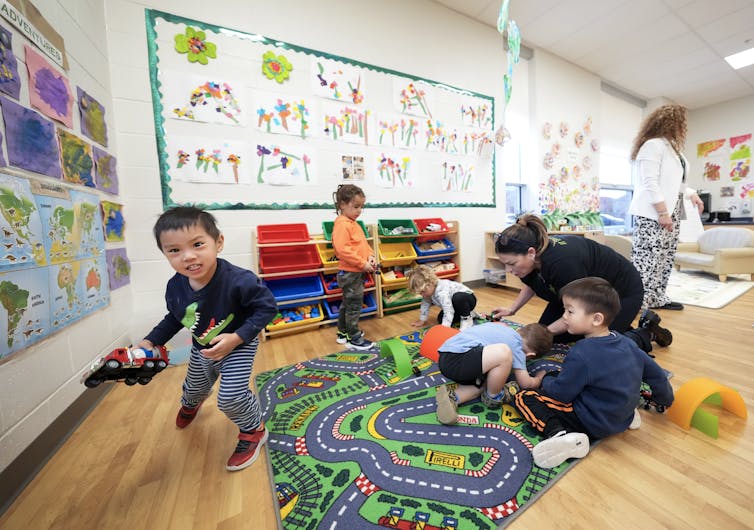Education
Prime Minister Carney’s Budget Leaves Child Care Expansion on Hold

Prime Minister Mark Carney has announced a federal budget that halts progress on early learning and child care, despite ongoing shortages affecting families across Canada. While the Prime Minister claims to be “protecting” the $10-a-day child care program, critics argue that inaction equates to regression. The budget maintains previously committed funding of around $8 billion annually for child care, which will extend federal transfers to provinces and territories for five years. This includes approximately $150 million each year for capital funding. Currently, over 900,000 children benefit from the program, yet the Liberal Party’s electoral platform promised an additional 100,000 spaces by 2031 on top of the 250,000 already pledged by 2026.
The budget notably omits any reference to these commitments, raising concerns about the future of high-quality child care in the country. The Liberal Party has previously emphasized that the $10-a-day program is a fundamental element of Canada’s social infrastructure, asserting that it must not be diminished or eliminated. Yet it appears that the current budget does not align with these promises.
Canada’s Child Care Crisis
The federal government aims to ensure that all families can access affordable and inclusive early learning and child care. Despite the existing program serving more than 900,000 children, a recent analysis of Statistics Canada data reveals a significant shortfall in child care spaces. Outside of Quebec, there are approximately 278,000 children waiting for access to child care. If the goal is to provide spaces for 59 percent of all children aged zero to five, Canada would require an additional 384,000 spaces.
This gap has prompted complaints from larger provinces that current federal funding levels are inadequate to support existing facilities, let alone expand capacity or offer higher wages to educators. According to Canada’s Auditor General, fewer than half of the promised child care spaces were created within the initial five years of the program.
Learning from Quebec’s Child Care System
As Canada navigates this critical phase in developing its early learning and child care system, lessons from Quebec’s experience are particularly relevant. Quebec’s child care program, initiated in 1997 by the Parti Quebecois, provided $5-a-day child care through a robust non-profit and family child care network. However, when the Liberal government under Jean Charest took over, the system faced challenges as private sector involvement grew, leading to increased costs and decreased quality in many facilities.
The federal government has emphasized that expansion should predominantly occur within the non-profit sector to ensure quality. Yet, without sufficient capital support, some provinces are considering a shift towards for-profit models, which could undermine the quality of care.
The 2021 federal budget described the $10-a-day child care initiative as a strategy to promote economic growth and secure women’s roles in the workforce. Achieving these objectives is crucial for Canada’s economy. For instance, in Quebec, over 85 percent of mothers with children are employed, compared to 79.2 percent across Canada. If Canada could match Quebec’s employment rate, it would mean over 220,000 more women in the workforce, contributing significantly to family incomes and government revenue.
Experts like Gordon Cleveland, a member of the National Advisory Council on Early Learning and Child Care, advocate for immediate actions to enhance access and quality of child care. He suggests prioritizing funding for non-profit expansions and unlocking the $1 billion loan program promised in last year’s budget to support these initiatives.
In conclusion, Prime Minister Carney’s budget represents a critical juncture for early learning and child care in Canada. With pressing needs for additional spaces and quality improvements, stakeholders urge the government to reconsider its priorities and invest in the future of child care as a vital component of national infrastructure.
-

 Science3 months ago
Science3 months agoToyoake City Proposes Daily Two-Hour Smartphone Use Limit
-

 Health3 months ago
Health3 months agoB.C. Review Reveals Urgent Need for Rare-Disease Drug Reforms
-

 Top Stories3 months ago
Top Stories3 months agoPedestrian Fatally Injured in Esquimalt Collision on August 14
-

 Technology3 months ago
Technology3 months agoDark Adventure Game “Bye Sweet Carole” Set for October Release
-

 World3 months ago
World3 months agoJimmy Lai’s Defense Challenges Charges Under National Security Law
-

 Lifestyle3 months ago
Lifestyle3 months agoVictoria’s Pop-Up Shop Shines Light on B.C.’s Wolf Cull
-

 Technology3 months ago
Technology3 months agoKonami Revives Iconic Metal Gear Solid Delta Ahead of Release
-

 Technology3 months ago
Technology3 months agoApple Expands Self-Service Repair Program to Canada
-

 Technology3 months ago
Technology3 months agoSnapmaker U1 Color 3D Printer Redefines Speed and Sustainability
-

 Technology3 months ago
Technology3 months agoAION Folding Knife: Redefining EDC Design with Premium Materials
-

 Technology3 months ago
Technology3 months agoSolve Today’s Wordle Challenge: Hints and Answer for August 19
-

 Business3 months ago
Business3 months agoGordon Murray Automotive Unveils S1 LM and Le Mans GTR at Monterey









